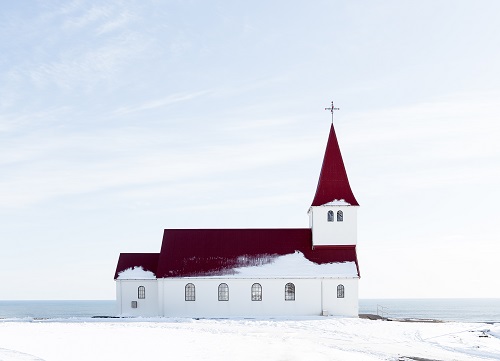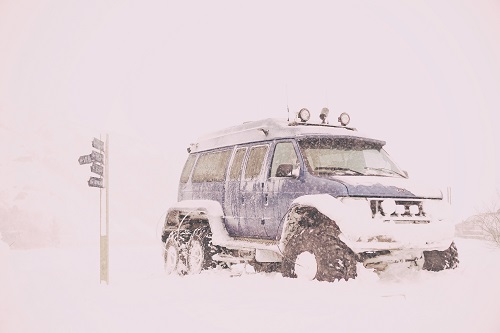Many people who come to visit Iceland are concerned about the prospect of driving in the snow. This is a legitimate concern. Driving in the winter can be more difficult and more dangerous, especially for those who have not done so before.
With the proper precautions, appropriate car and tires, driving in the snow in Iceland can be done in a safe and enjoyable way, so long as you avoid the biggest risks. Here, we provide you with a guide to driving in the snow in Iceland.
Driving in Iceland During the Winter
There are a lot of tips out there for everyday driving in Iceland and one of the most common pieces of advice is to check the weather conditions and follow safety advice. This is no exception during the winter.
Some main things to always keep in mind are:
- Drive on the right side of the road.
- Make sure that your headlights are always on, day or night.
- Purchase gravel insurance.
- The emergency number is 112.
- It is illegal to drive off-road in Iceland.
Driving in Iceland is always something to prepare for, no matter the season, as the weather can be exceptionally changeable. Although it is an extra challenge driving in the winter, it's an exceptional time to see Iceland, and you will make unforgettable memories on the road.

What You Shouldn’t Worry About Driving in the Snow in Iceland
There are a lot of posts and people warning of the dangers of driving in the winter in Iceland. You may hear stories about accidents, problems and all sorts of issues that have happened in the past, but it’s important to note that it’s the small percentage of people with bad experiences that have the loudest voices. Generally, for snowy conditions, you’ll need a good deal of common sense, and that’s about it.
You don’t have to worry about getting stranded, especially if you are on the major roads around Iceland. Nearly everyone is incredibly friendly and helpful and will be able to give you advice. The majority of the undrivable roads, like the Highland roads, will be closed during the winter anyway, so it is unlikely that you will be able to drive on Iceland’s most difficult roads in the snow.
Things to Keep in Mind While Driving in the Winter in Iceland
Winter is a different beast in Iceland, with variable and often dangerous weather and road conditions. There are many road closures, with the Highlands completely closed off until the end of June or early July. The Ring Road is always well-maintained, so should be accessible throughout the year, but there are certain severe weather conditions when you might even want to avoid this road.
Winter in Iceland lasts from early November to the end of April, but winter storms may still occur as late as May. During this season, there are additional concerns when driving around Iceland. Our top tips for driving in the snow in Iceland include:
- Maximise the hours that you have available, as you will only have a few hours in sunlight.
- If you are driving after sunset, there are additional challenges - read our tips on driving in Iceland at night.
- Be careful when opening or closing car doors in the wind, as it could slam shut or open quickly and break the hinges.
- Use studded tires to ensure that your car has a grip on the ice and snow.
What Items Should You Carry while Driving in Iceland in Winter?
With the unpredictability of driving in the snow in Iceland, we advise bringing gear in case of emergencies. Because no matter how much preparation and forward planning you do, the universe could still cause a bit of a problem. Here are some items to take with you while driving in Iceland during the winter:
- Spare tires and the equipment to change it.
- List of important phone numbers.
- Snow and ice scraper.
- Flashlight and extra batteries.
- Extra phone battery/charger.
- Emergency first aid kit.
- Emergency blankets (for warmth and also to get out if a tire gets stuck).
- Warning triangle.
- Extra drinking water.
- Collapsible snow shovel.
- Road flares.
- Antifreeze.
- Strong rope (it can be used to help pull your car out of snow).
- Emergency beacon (most useful for hikers and solo travellers).
What to Do Before You Drive in The Snow in Iceland?
One of the best things to do before setting off for your snowy adventure is to add more time to your travel plan. Things will never happen as fast as you plan for them to happen during the winter. Small things will quickly eat into your travel time: clearing the car of snow and ice, stopping for photos, and an endless number of things that could delay your journey. Make sure that you leave plenty of time for these and aren’t rushing your trip. Taking your time considerably reduces the risk of accidents.
Another thing to do before setting off is to check your wipers. The auto wiper control should be switched off, but check before turning on the ignition. If the wipers start while frozen, it could blow the fuse and break.
De-icing the car is an important and tedious job. You may be tempted to cut corners and de-ice a quick way. But, do not use hot water to de-ice the windscreen. The sudden temperature change could crack the windscreen. Don’t use lukewarm water either, as it’s just adding extra water to freeze on your windscreen. Instead, start the defrosters and get rid of the ice the old-fashioned way – with a scraper.

How to Drive in the Snow in Iceland?
Once the car has been de-iced and is ready to go, follow these useful advice tips for driving in the snow. For many visitors to Iceland, it can be daunting to drive in these conditions and for some people, it's their first time ever. We’ve broken down the 10 essentials to keep in mind.
1. When driving in snowy and icy conditions, do pull away in second gear, gently releasing the clutch so your wheels don’t spin on the ice.
2. Drive slowly. Stopping distances can increase over 10 times on ice and snow, so brake in advance, driving as smoothly as possible.
3. Accelerate gently, use lower revs and move into higher gears as soon as possible to maintain traction.
4. When driving uphill, leave plenty of room so you can maintain a constant speed (try to avoid changing the gear) until you reach the top. When driving downhill, do use a low gear, drive slowly and try to avoid braking.
5. If you do have to brake, make sure that it is as smooth as possible. If the car has ABS (anti-lock braking system), it is trying to prevent the brakes from locking up. Don’t let go of the brake until you need to.
6. When accelerating, make sure that you are gentle and smooth with the changes, taking extra time to reach your desired speed.
7. For all of the motions, smoothness is key, otherwise, your wheels could lose traction and you could lose control by either over or under-steering.
8. Over-steering is when the rear tires lose their grip and start to turn the car. Do not slam the brakes or overcompensate. Instead, do steer into the skid and gently accelerate to regain control.
9. Under-steering is when the front wheels skid, normally in the direction that you are turning. Do not steer harder into the turn or slam onto the brakes. Instead, do remove your foot from the accelerator and slowly turn your wheel back straight.
10. In general, the best advice is to drive slowly and maintain awareness of your environment. We’re always happy to answer any questions about driving in winter conditions, so please check with us when you collect your car.
At Reykjavik Rent A Car, we aim to get you on the road as quickly and safely as possible. Speak to us today and get your car secured.
Want to know more about snowfall in Iceland? Find out how much it snows in Reykjavik.